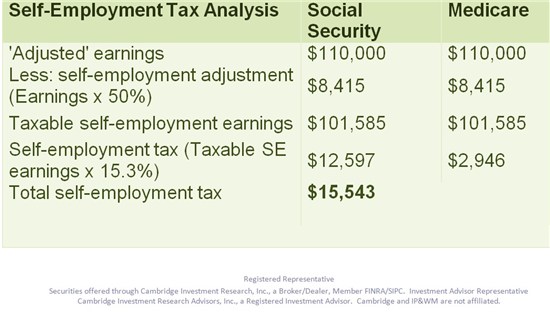By Adam Cmejla, CMFC

SYNOPSIS
Keep more money in your pocket by applying five simple strategies that reduce your tax liability.
ACTION POINTS
CHANGE TAX FILING ELECTION. You could save on “self-employment” taxes if you elect to have your business file as an S-corp or partnership instead of as a sole proprietorship.
ESTABLISH RETIREMENT PLAN. If your practice has net income at the end of the year that must be passed through to the business, you can pay either the federal government in taxes or yourself through a retirement plan.
LEASE EQUIPMENT INSTEAD OF PURCHASING OUTRIGHT. When leasing, 100 percent of the lease payment is usually tax deductible in the year that it’s paid.
As a financial advisor with many optometric clients and the husband of an OD, I know how taxes limit personal savings and practice profitability. Here are five strategies I recommend to limit your tax burden.
Change Your Business Tax Filing Election
Many ODs we work with came to us with their practice already established. When we get to the part of the planning process that looks at their income tax (both personal and professional) returns, one of the first areas that I look at is the type of return filed for their business. Was it a Schedule C (Sole Proprietor), Form 1065 (a Partnership) or Form 1120-S (Subchapter S-corporation)? Depending on production numbers, an established practice could save significantly on “self-employment” taxes paid if the owner were to elect to have their business file as an S-corp or partnership, depending on the corporate structure. Let’s look at an example to see how this is demonstrated with an optometrist who has net income of $110,000.
As a sole proprietor, a net income of $110,000 is run through the filter of self-employment (SE) calculation. The following table illustrates the steps necessary to calculate total tax liability. Keep in mind that this income is still subject to normal federal and possible state and local income tax schedules and rates.

Now consider if the OD were to switch to an S-corp and pay him or herself a “reasonable wage” (per IRS requirements) for an optometrist of $75,000 in W-2 income, and take the rest of the income as a distribution of business income, which will show up on Line 17 of the optometrist’s 1040 rather than Line 12. The key differentiator in this scenario is that the $35,000 difference in W-2 wages and total business income ($110,000 – $75,000) is not subject to the 15.3 percent SE, thus saving the OD approximately $5,355 come tax time.
Establish A Retirement Plan
Along the same line as the organization of a business, implementing a retirement plan is another way to minimize your tax liability. The simple, cut-and-dry explanation of this strategy: if your business will have net income at the end of the year that must be passed through to the business, you have the option of paying one of two “people”: either the federal government in the form of taxes or yourself through the implementation of a retirement plan. Through proper selection and strategies, the right retirement plan can allow you to shelter profits from the business into a retirement plan, thus reducing your taxable income come tax time.
Purchase vs. Lease Equipment
We get this question a lot: “Should I buy or lease equipment?” While there’s no absolutely right or wrong scenario, proper tax planning does play into the equation. When purchasing outright, the optometrist must repay both principal and interest, however only the interest is deductible. The principal isn’t considered an expense on your Profit/Loss, but rather a repayment of principal, and therefore, is not deductible. When leasing, however, 100 percent of the lease payment is usually deductible in the year that it’s paid.
Employ Your Spouse
Employing your spouse can be used as a combination benefit of the first and second strategy already mentioned. Let’s say that an optometrist is generating significant net income in the practice, and their spouse helps out in the practice in a legitimate way, such as practice management, clerical work, billing or reception.You’d be surprised how many ODs I know who have their spouse just helping them “on the side,” and thus, not thinking that they could pay them. The spouse helps out from time to time…maybe occasionally on the weekends or doing billing, etc, from a home office. They don’t consider them “part of the staff,” so they don’t bill them. By paying their spouse a nominal wage, that is again within reason of the IRS rules, the spouse could then potentially defer a significant portion (perhaps 100 percent) of their compensation into the practice’s retirement plan.
For example, let’s say a practice decides that it’s best solution is to implement a 401(k) Profit Sharing plan into the practice. With proper structure and provisions, the owner could pay his spouse a salary as much as $52,000 and potentially $57,500 if the spouse is over the age of 50 due to the “catch up” provision that the IRS allows for participants in a retirement plan if they are over the age of 50. In 2014, for 401(k)’s, someone over 50 can put in an additional $5,500 per year. Important note: the proper retirement plan selection, especially a qualified plan such as a 401(k), has a lot of “moving parts,” with tax law frequently changing. So, it’s important to make the right decisions the first time around and work with a qualified advisor to serve you properly in this process. Not doing so can have significant penalties, costs and additional stress and paperwork with the IRS and Department of Labor.
Don’t Overlook the Small Expenses
Many optometrists we talk to don’t add upthe small details that amount to significant dollars at the end of the year. Do you log into your practice management software or EHR from home? Track time and deduct appropriately your home internet use. Do you use your personal cell phone when returning patient calls or handling emergency “on call” situations? Deduct your cell phone expenses accordingly. Do you wear scrubs on certain days or pay to have a lab coat professionally cleaned? Save the receipts and cleaning invoices!
Word of caution: You are not able to deduct expenses for your professional wardrobe that otherwise could be worn in your personal lives. This means the nice suit you bought and wear to the office cannot be deducted, since you could wear that outside of your normal business activity. Outside of a Halloween party, I don’t think you’ll be wearing a lab coat or scrubs to other personal functions. Travel around to different offices building up your partner network? Be sure to track your mileage: $0.56/mi for business mileage really adds up. While you cannot deduct the mileage driving from your primary residence to your primary place of employment, all other mileage due to business activities is track-able.
There are multiple ways to ensure that you are being as effective and efficient as possible with your tax planning. While we are not CPAs by trade, and always work with a qualified CPA/tax professional on these matters, all of the planning that is important for your long-term financial success needs to be done with a significant amount of tax planning and sensitivity in mind. It’s important that the team you have in place serving you, your family and your practice understand your unique business model and the possibilities that exist to help you grow, protect and preserve your wealth and financial independence.
Related ROB Articles
Alternative Minimum Tax: Investing in Your Practice May Reduce Your Tax Bill
The New 3.8 Percent Tax: Strategies to Keep Money in Your Pocket
Refract Your Finances to 20/20: Put More Money Away for Retirement
Adam Cmejla, CMFC, based in Carmel, Ind.,is president of Integrated Planning & Wealth Management, LLC, a financial planning and investment management firm “focused on working with optometrists to help them achieve their true financial potential, build financial confidence and clarity, and “delivering kindness and compassion to every relationship they’re privileged to serve.” To contact him: (317)853-6777 or adam@integratedpwm.com.

























